Get PeakVisor App
Sign In
Search by GPS coordinates
- Latitude
- ° ' ''
- Longitude
- ° ' ''
- Units of Length
- Temperature

Yes
Cancel
Share ×

Scan the QR code and open PeakVisor on your phone
❤ Wishlist ×
Choose
Delete
Mont Tremblant Ski Resort (also known as Tremblant) is one of over 80 ski resorts in the province of Quebec, in Eastern Canada. Nestled in the ancient Laurentian Mountains, Tremblant is one of Eastern North America's top resorts. It has a peak elevation of 875 m (2,870 ft), a vertical drop of 645 m (2,116 ft), 82 km (51 mi) of ski trails, and one of the most well-equipped snow-making systems in the industry.
Mont Tremblant is a winter oasis filled with every winter activity you can imagine. Naturally, the jewel of Quebec offers on-piste skiing opportunities and some open-gladed riding and is rather large as East Coast standards go. One hundred two runs over four mountain faces, to be exact. However, with a bustling European-inspired village at the base, impressive entertainment, and a distinct French charm, this ski resort offers guests an exciting ski holiday and a well-rounded experience. It’s especially worthwhile for American East Coast-ers looking for a bit of foreign flavor without the hassle—or carbon footprint—of traveling to Europe.
Moreover, prices here are in Canadian dollars; US dollars, euros, pounds, and other Western currencies are subject to a favorable exchange rate (as of Oct 2024, the exchange rate is 73 US cents per Canadian dollar).
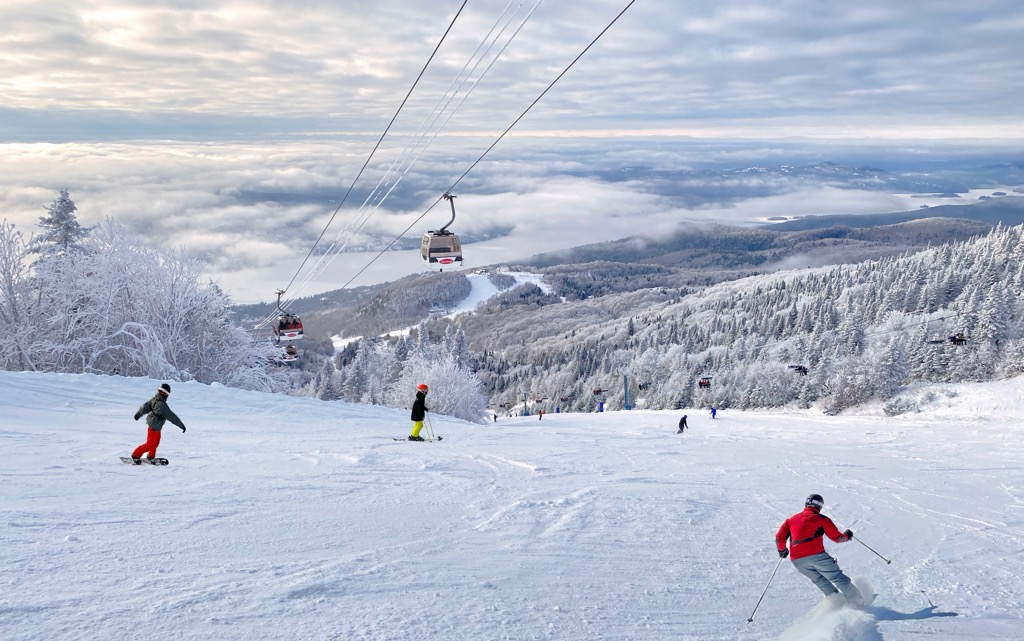
Mont Tremblant Ski Resort is in the eponymous picturesque town of Mont Tremblant, about 13 km (8 mi) from the town center. It’s in the southern region of Quebec, in Eastern Canada. Montreal is the closest major city, only 132 km (82 mi) southeast. Ottawa, the nation's capital, is 150 km (90 mi) away.
Geographically, the resort sits on Mont Tremblant Mountain in the Laurentian Mountain Range. The aforementioned range is one of the oldest on earth and spans Newfoundland, Labrador, Quebec, and Ontario. It was formed over one billion years ago as part of the Grenville orogeny. Today, these mountains exhibit more rounded peaks and gentler features due to an eon of exposure and erosion from Mother Nature.
Mont Tremblant Ski Resort also lives in Mont-Tremblant National Park, known for great skiing, hiking, and stunning landscape vistas accentuated by vibrant fall colors.
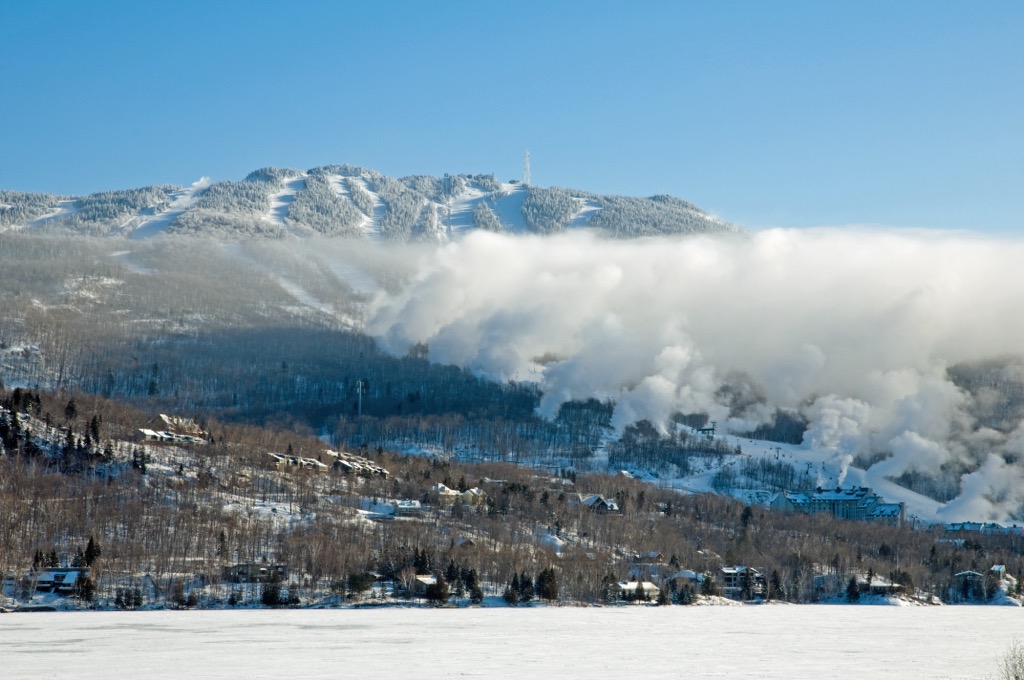
Mont Tremblant Ski Resort is relatively easy to get to, given its proximity to an international airport.
The Montreal International Airport (YUL) is the nearest airport to the ski resort. It’s 125 km (77 mi) away and takes just under two hours to drive. Rental cars and plenty of shuttle options are available to get you to the resort.
There are several rental companies at YUL, and it’s relatively affordable. You’re looking at about $50 a day for a standard car.
After leaving the airport, get on A. 520 E from R. Jacques-de-Lesseps/Bd Roméo Vachon and Av. Michel Jasmin. Follow Autoroute 13 N and Autoroute 15 N to Rte Transcanadienne/QC-117 N in Sainte-Agathe-des-Monts. Finally, Follow Rte Transcanadienne/QC-117 N to Rue Léonard/QC-327 N in Mont-Tremblant.
The drive is quite scenic as you travel through old farmland and make your way up into the mountains. The last 40 minutes are full of twisting mountain roads with narrow passages. You’ll definitely want winter tires for this drive.
Important: If you drive to Mont Tremblant, you must purchase a Canada Discovery Park Pass at $80 or $8 per person in your vehicle.
The Orléans Express - KEOLIS and Tremblant offers two trips per day in luxurious coach transportation from the Montreal International Airport to Mont Tremblant. It costs $95 for a one-way or $161 round trip.
Tremblant offers private transfers in luxury cars, vans, and buses for groups or VIPs. Prices range from $400 for a private car, $600 for a limousine, and $1000 for a bus.
Several parking lots around the resort have different day / night rate options. Parking Lots 1 - 5 are generally free except for special events. P6 - P11 are paid parking. Electric charging stations are available at multiple locations in the village.
Mont Tremblant also has lots of overnight parking. Hotels have secure underground parking for around $25 a night.
Getting around the town of Mont Tremblant (St Jovite) is fairly straightforward. Ville de Mont-Tremblant offers public transportation to get around the actual town, with routes to take you to the ski resort if you’re staying in town. Taxis are available.
Moving around the actual ski resort is easy and fun. Roads surround the entire pedestrian village, and a free resort shuttle circles regularly. The village is easily walkable, and walking is definitely recommended!
Need to move from the south part of the village to the ski base? There’s a gondola for that. The Le Cabriolet is a 6-person, 321 m lift that rises above the village's many hotels and buildings, allowing for some impressive views.
What about on the way down? Well, you can actually ski through the village on specially marked “ski trails” that wind their way through the backside of buildings. Just mind your speed, as these trails are narrow and see heavy traffic.

The ski season at Tremblant starts in late November and wraps up in mid-April, an impressive feat for an East Coast resort. Visitors can enjoy almost five months of skiing; many major West Coast resorts have a similar length season.
The time from opening to mid-December is considered the “early season.” Expect mild coverage, some unopened areas, and a much quieter atmosphere. It snows regularly during this time, but the resort's arsenal of snow guns dependably supplements the base depth each night. Nevertheless, the terrain can still be limited and conditions can be icy. With more grooming and natural snow accumulating, the resort continues to take shape but skiing at this time can be hit or miss.
Christmas is of course the busiest and most exciting time of the year. Uploading in the mornings, especially at Le Cabriolet, takes a long time. Once you reach the summit, people spread out and lift lines aren’t too bad.
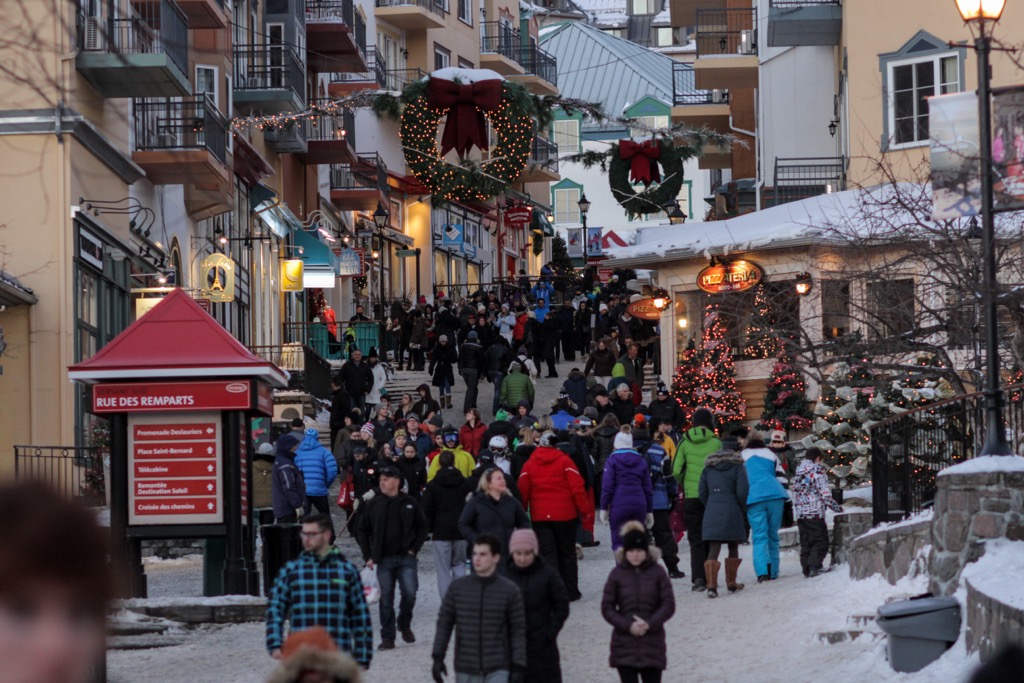
January and February are the core skiing months. The resort’s terrain is fully open, snow is plentiful, and many activities and festivals occur weekly. Visiting on weekdays provides the best opportunity for short lines and lots of fast skiing.
Once March hits, temperatures start to warm up but the snow still falls and skiing chugs on. The snow is much more packed during this time, and you’ll likely find some ice on the slopes. March sees an increase in visitation as both families and university students make the trek to the slopes.
Snow accumulation and visitation drop off in April; spring conditions are standard, with super icy mornings and soft spring snow by the afternoon. It snows here during this time, but the resort can also see rain at the base. Spring conditions can be fun, and Tremblant embraces the changing weather with an annual Slush Cup in mid-April to send off the season.
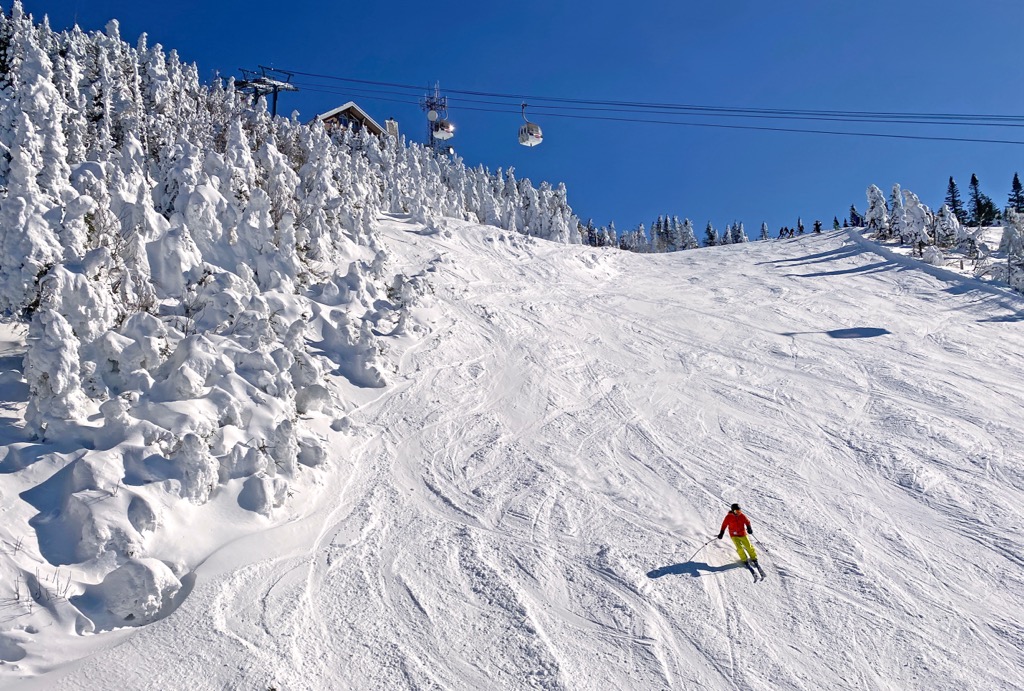
Tremblant's snow is a mixture of drier East Coast snow, periods of heavy wet snow, and a considerable amount of artificial snow making up the base, even right at the peak. Skiers can normally expect hard-packed on-piste conditions through most of the season.
Typically, the snow is excellent for skiing fast. Off-piste can be hit or miss. With ample coverage from storms, you can get some decent conditions in the trees, but they can also be full of ice. There will be times of ice on-piste depending on the weather, sun exposure, and ski traffic. Remember, you’re still skiing on the East Coast, and sharp edges are recommended. The conditions are generally better in the morning before the groomed snow is scraped off to the side by a day’s worth of skier traffic.
The ski resort receives 5 m (15 ft) of natural snow annually. They rely heavily on artificial snow at times, and with over 1,200 snow guns in their arsenal, the resort can transform overnight.
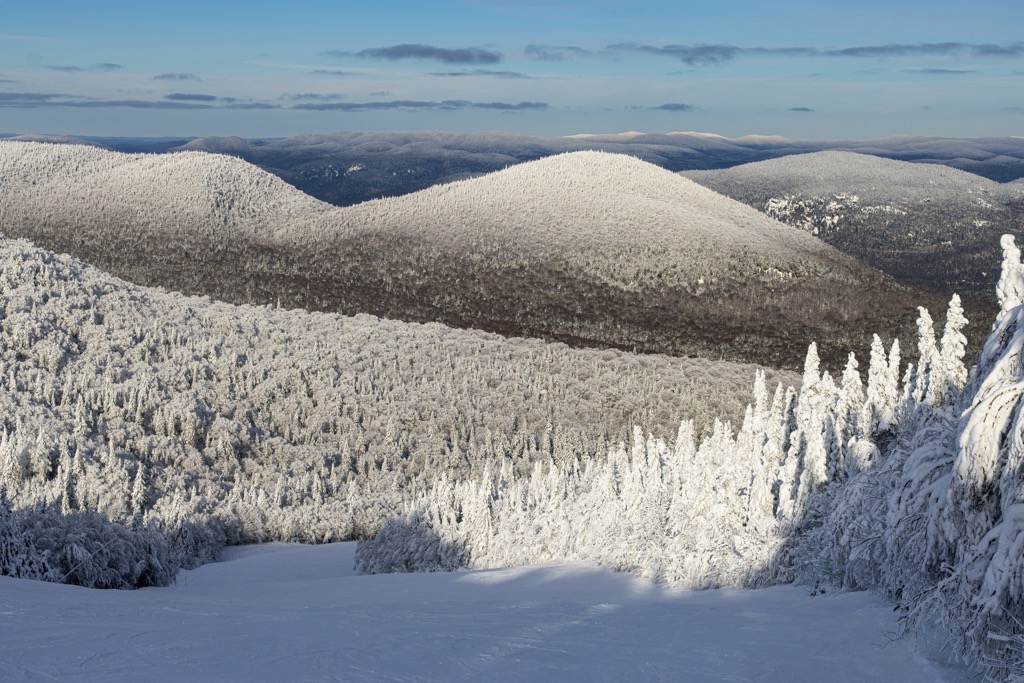
Temperatures in Mont Tremblant and at the resort can be chilly in the midst of winter, especially as the resort is known for its windy days. Throughout the winter, you can expect temperatures ranging from 0 to -10℃ at the base to -10 to -15℃ at the peak. Occasional cold snaps drive the peak temperatures below -25℃.
January and February are usually the coldest months at the resort. You’ll want to prepare by bringing plenty of warm, windproof layers and a cold-weather rub-on ski wax. The lack of moisture in the snow and the abundance of artificial snow means sticky skis and base burns happen quickly.
Occasionally, rain and freezing rain make the resort a slippery mess. For what it’s worth, the resort does a tremendous job of grooming runs after freezing rain. It’s important to always check the grooming reports after these events.
The ski resort consists of the Pic Blanc (a subpeak of Mont Tremblant) (875 m / 2871 ft), the Pedestrian Village, and the Old Village. The slopes occupy both the north and south sides of the mountain. The Pedestrian Village starts right at the mountain's base, whereas the Old Village sits about two kilometers down the road.
The entire resort is self-sustained outside the town of Mont Tremblant (St. Jovite) and has everything you need to enjoy a ski getaway. With that said, let’s break down this unique resort, starting with the Pedestrian Village.
Pedestrian Village is at the foot of Mont Tremblant Resort, with all the shops, restaurants, hotels, bars, and all the Après fun. The village mimics a quaint European ski town; colorful buildings line narrow streets and well-connected alleys.
It's less than one kilometer from the main parking lots to the end of the village. The village is also split into an upper and lower area with a pedestrian gondola (The Cabriolet) linking the two. You can, however, walk (or ski) the entirety of the village with ease. Here is the resort’s official Village Map.
Old Village, located on the shores of Lake Mercer, sits between the Pedestrian Village and Tremblant's downtown core. It’s a tiny village with a bit of additional accommodation, restaurants, cafes, artisanal shops and quieter pubs. Old Village is where you stay if you’re looking for a more peaceful environment with walking trails and forest access.
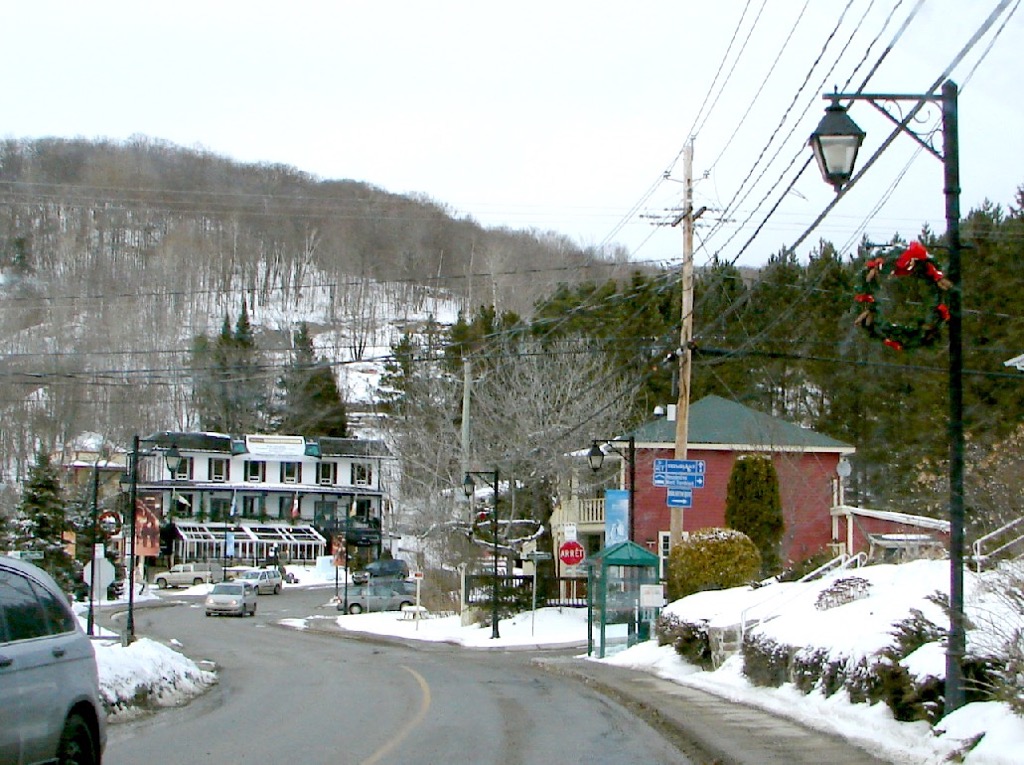
To access Mont Tremblant Mountain, make your way to the Versant Sud or South Side of the resort. You can take either the Express Gondola or Flying Mile quad chair to make your way up the mountain. Alternatively, hop on the Casino Express Gondola for a short ride and ascend Le Soleil to access Versant Soleil.

Check out the app for thousands of lifts, trails, ski tours, peaks, cabins, parking areas, and more worldwide. It’s all on here. You can also upload .gpx files if we don't already have a trail on our servers. The PeakVisor app is available for iOS and Android; give it a shot and discover our visually stunning 3D Maps, adding a new dimension to your alpine adventures
Versant Sud, or South Side, is the most built-up area at the resort. You’ll find most of the resort’s green runs, slow zones, and beginner areas here. There are also black and double black runs off the peak with several blue runs scattered from top to bottom. The double black runs are usually pretty bumpy and, at times, icy. They’re steep, but the double-black designation comes more from the conditions than the terrain.
Three different lifts move you from the base to the peak, allowing skiers to lap either the bottom or top halves. Express Gondola takes you to the top, where Flying Mile gets you up about halfway, and TGV takes you the rest. TGV is well positioned to allow skiers to quickly lap the black and double black runs off the peak.
Located on the most southern side of the resort (right side), this zone is one of the best on the mountain. One chairlift provides skiers with top-to-bottom runs and no option to ditch halfway. That’s what makes this area less busy.
The majority of the groomed runs here are blue and black with one meandering green run from the peak to the base. There are also a few pockets of tree skiing here and there. Ski runs here were designed to twist and turn down the mountain while presenting natural rollers, flats, and steep straightaways that make skiing feel like a rollercoaster. The runs here can be on the narrower side, so be mindful of big sweeping carves.
When the conditions are right, you can absolutely rip down these runs. This zone does seem to get less attention from the groomers so always check out the grooming report before venturing over. Laurentienne is a stunning groomed black run with a fantastic valley view. With lots of twists, turns, and even some airtime, this fast-flowing black track is one of Tremblant’s best.
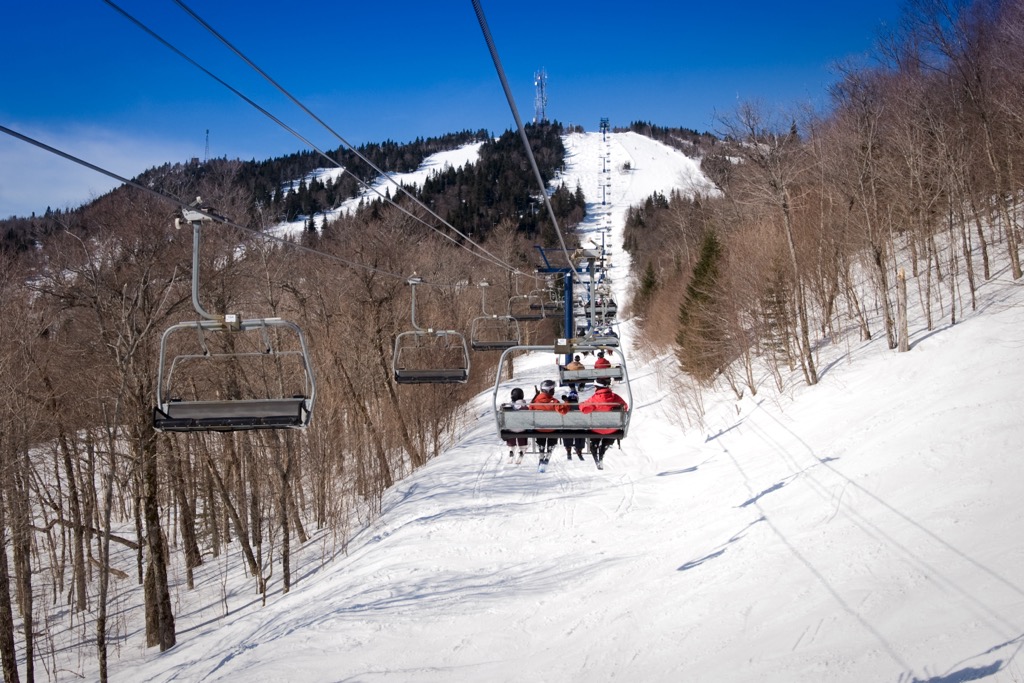
On the backside of Mont Tremblant lies Versant Nord or North Side. You access this entire area by making your way to the peak and then dropping down on the backside of the mountain, opposite the village. Three high-speed quad chairs service this zone's terrain which is more geared to intermediate and advanced skiers. Gladed areas are more noticeable here with these zones spread around this side of the mountain and in Le Edge on the far right.
There's also a large chalet at the base with food, shops, rentals, and parking. Yes, you can drive to this side, but it will take much longer. It’s about 12 km (7.5 mi) from the main village; however, avoiding the crowds at the base may be worth it. The crowds never seem to make it, so it’s still enjoyable, even on busy days.
The left side of Versant Nord has more advanced terrain. The black groomers are a touch narrower and usually well-groomed, whereas most double black runs become mogul farms. The right holds more intermediate and novice terrain except for Le Edge, which is the most natural face of the mountain. This entire zone is gladed with no one path down. It’s a pick-your-own adventure through the natural trees of the boreal forest.
Mont Tremblant has 102 marked runs, most of which are exclusively groomed terrain. The skiing here is more geared to on-piste slopes with no real freeride terrain. It’s just how East Coast skiing goes. There are, however, a few terrain parks spread around the mountain to satisfy your need for airtime.
Most of the ski runs on the top half of the mountain are steeper black runs, with the grade mellowing out as you near the bottom. There are a few gladed areas, noticeably Le Edge on the backside.
As at other resorts in North America, slopes are broken into four categories: beginner — green circles, intermediate — blue squares, and advanced / expert — black / double-black diamonds.
Fourteen lifts make up the lift system at Mont Tremblant, all well-positioned to allow for easy movement around the resort. They include two gondolas, nine chairlifts, and three surface lifts.
Slopes
Ski lifts
Other features and services
Dozens of backcountry ski routes traverse the confines of Parc National du Mont Tremblant. These can be as simple as day trips or string multiple tours together with an overnight hut adventure. Backcountry skiing is so well established that even the resort hosts “Ski Touring Demo Days.”
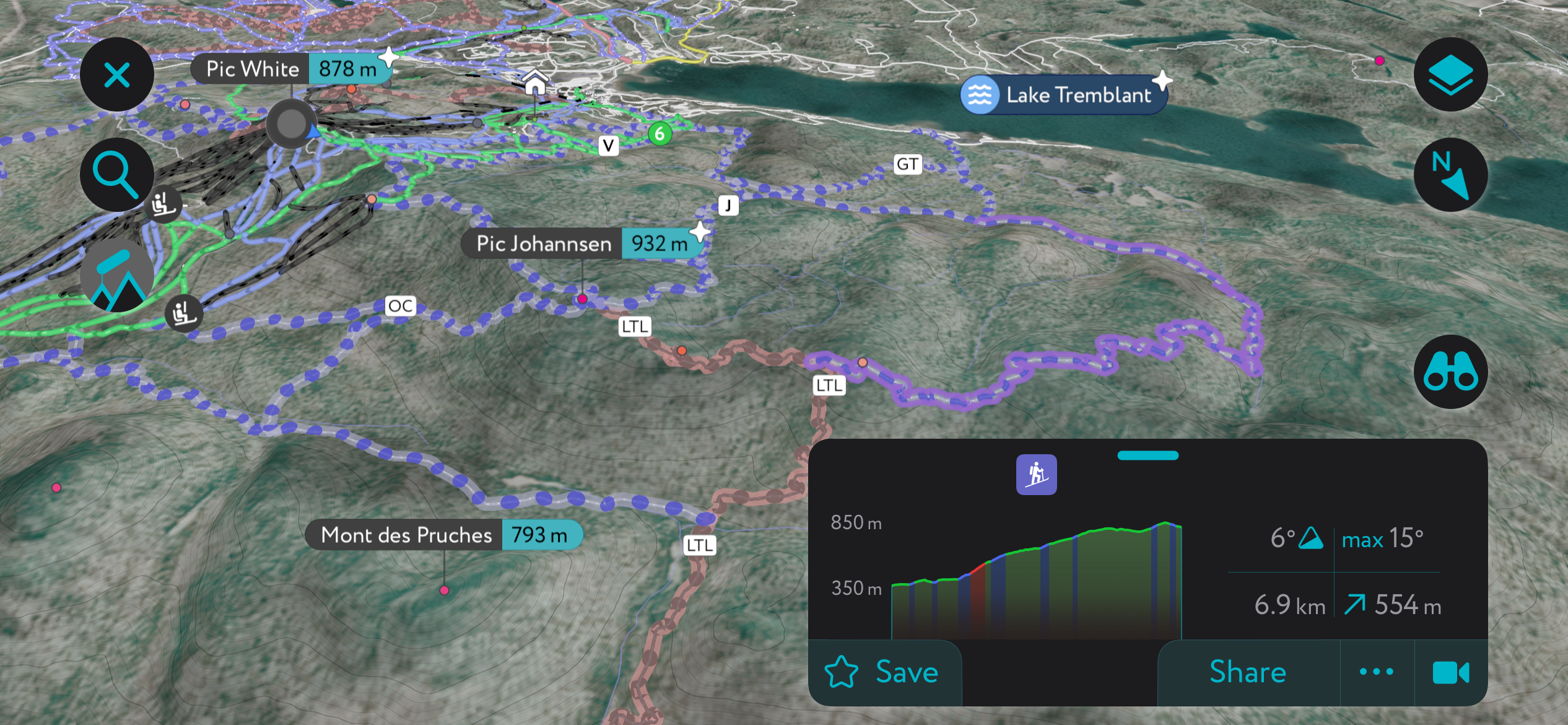
Mont Tremblant offers guided tours and backcountry access on designated uphill and downhill routes at the resort. The resort’s hiking and touring map is here. This can be a low-risk way of entering this discipline, as avalanche risk is essentially zero here. You will encounter more chilly conditions for touring, so finding the right mix of breathable and insulated clothing is paramount.
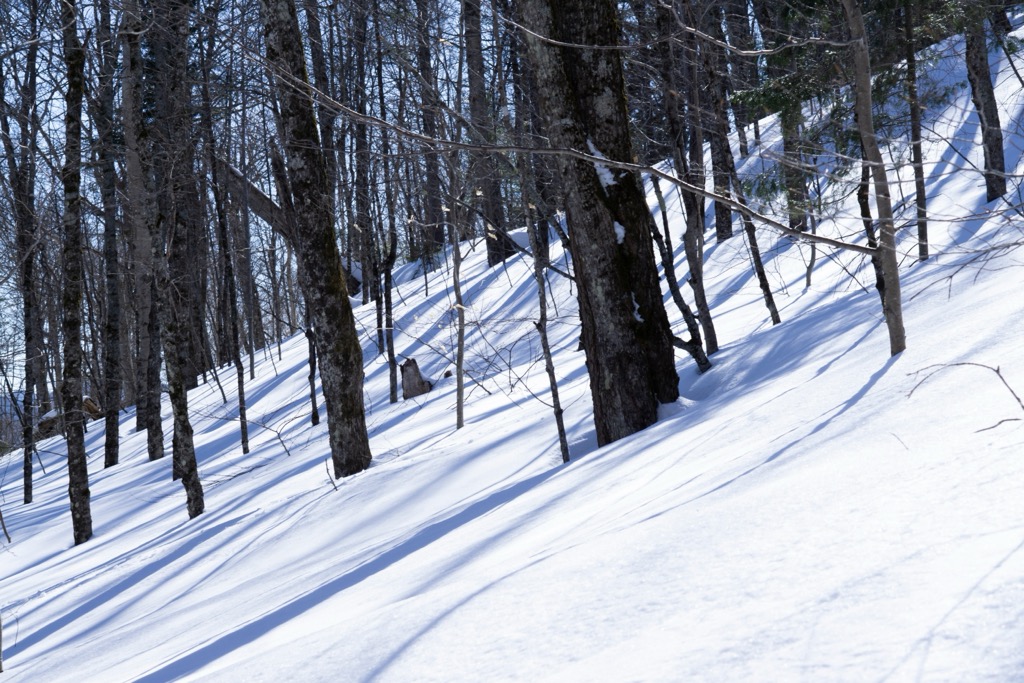
The tour to Refuge de Trappeurs in Versant Soleil is fairly straightforward. Start at the base of Le Soleil, head up Nord Sud, switch to Tour Du Timber, and split off towards the chalet. The uphill route is about 5 km and will take around 3-4 hours.
Alternatively, you can take Johannsen on the opposite side of the resort to reach Le Edge. It’s 8.4 km (5.2 mi) to the summit, and cell phone service can be spotty. This is not for the ill-prepared. Expect to take 5 hours.
If you head North, deep into Mont Tremblant National Park, you’ll be welcomed to a world of backcountry terrain, huts, and multi-day trips you can plan. Pimbina-Saint-Donat is a 12.5 km lap you can do in a day but there is a hut available (highly recommended).

At Mont Tremblant, there are multiple pass products and discounts to let skiers find the best rates and flexibility when wanting to ski at this resort.
The regular rate pass is typically $142. However, it’s $177 from December 27-21 and $160 from Jan 1-3, February 15-20 and all Saturdays in Jan-March. Multi-day ticket options can be as low as $99 per day if you plan on skiing on weekdays. Lift tickets can be purchased here.
Mont Tremblant is part of the IKON Pass, allowing unlimited access and up to 12 ski tickets discounted by 25% for friends and family. The IKON Pass starts at $1379. The Tonik Pass costs $820 but has a few date restrictions. Finally, the Nordik Card offers 2 to 4 days at $94 and 15% off day tickets thereafter. The card costs $188 and $282 respectively.
Mont Tremblant Ski Resort offers the majority of amenities and services you’d expect from a large ski resort. Between the resort and the nearby town of Mont Tremblant, you’re covered with everything you’d need.
Tremblant Snow School is the resort’s only dedicated snow school and guiding experience. Need to hone your skills or want a guide to take you to the best terrain? These guys have you covered. Private, group, teen, and kids lessons are all available here with maximum flexibility.
Mont Tremblant Guided Tours offers guests free tours of the ski resort. Sign up at the Guest Services desk located in Le Grand Manitou. Tours are available every day at 9:30 a.m. and 1:00 p.m.
Ski and Snowboard Rentals are offered from the resort. They have a large fleet of standard and performance rentals geared towards on-piste riding.
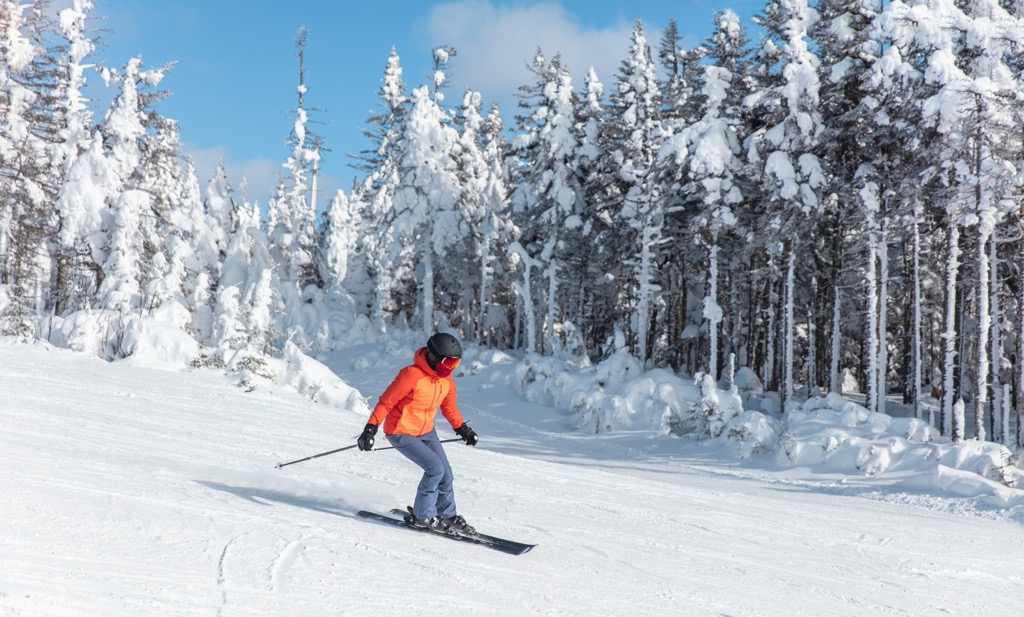
The dedicated contact information for Mont Tremblant is below:
+1 888.738.1777
Tremblant, 1000, Chemin des Voyageurs, Mont Tremblant, Quebec (QC), J8E 1T1, Canada
https://www.tremblant.ca/about-us/contact-us
The town of Mont Tremblant’s official tourist information center:
+1 819.425.8614
1145 rue de Saint-Jovite, Mont-Tremblant, Québec (QC), Canada, J8E 1V1
https://www.villedemont-tremblant.qc.ca/en/
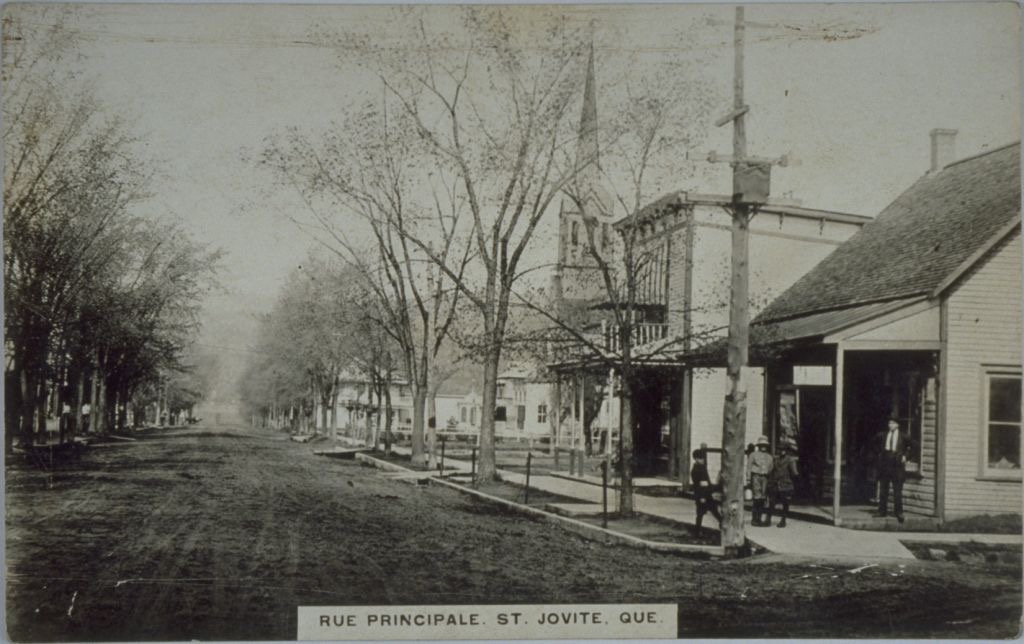
There are two main places to eat and drink at the resort: on-mountain or in the village. Here's what you need to know:
On-mountain food options are available in three locations: Le Grand Manitou at the peak, Le Refuge du Trappeur in Versant Soleil, and La Fourchette du Diable at the base of the North Side.
Each location offers something different but the largest and most stocked is Le Grand Manitou. This is your cafeteria-style eatery with typical ski chalet food like burgers, chili, pizza, etc. There are also a few healthy sandwich options. It’s expensive here, though; it's best to bring a bagged lunch if cost and health are important.
La Fourchette du Diable at the base on the North Side has similar food to Le Grand Manitou but also offers a sunny patio.
Le Refuge du Trappeur is a cozy log cabin halfway up Versant Soleil. Due to its size, only soup and hot beverages are offered, but the vibe is very peaceful with a wood-burning fire and great views of the valley.
Within the tiny Pedestrian Village, you’ll find over 100 food and drink venues to satisfy your hunger. Canadian, Italian, Asian, Mexican, French, steak, seafood, pizza, pubs, coffee shops, and bakeries line the streets, offering some of the best choices of any ski town in Canada.
Lucille’s Mont Tremblant is a community staple specializing in all things steak and seafood. Located in the Residence Inn by Marriott, this is consistently rated as one of the top restaurants in town.
La Diable Microbrasserie is a microbrewery located next to the slopes that offers beers brewed on-site and your standard pub fare. It’s an excellent place to après. Resto-Bar Le Shack is another long-time favorite in Tremblant for happy hours and sunny patio experiences.
You can also find two small grocery stores in Pedestrian Village. Forewarned, they are expensive.
If you venture into the main town, you’ll be welcomed by more affordable restaurants and a quieter atmosphere. My recommendation is this quaint sandwich shop called Smoked Meat Mont Tremblant. Why? You can’t come to Quebec without experiencing the smoked meats; this establishment represents just that.
Another popular spot is Ekki Sushi Tremblant. Although it’s a 15-minute drive from the village, it’s well worth the trek.
You’ll also find large grocery stores in the main town that you can access to cut down on food costs.
Finding accommodation for your ski holiday in Mont Tremblant can be split into two categories. You can stay in the Pedestrian Village for a ski-in-ski-out experience or in the nearby town of Mont Tremblant for a quieter and more affordable stay.
Staying at the Resort
The Fairmont Tremblant, located at the foot of the ski slopes, is the village's best-located luxury hotel. From the room options to a spa, restaurants, a concierge, and more, the Fairmont Tremblant takes care of every detail of your stay.
If you’re looking for the most luxury boutique hotel in Mont Tremblant, check out Hotel Quintessence. On the shores of Lake Tremblant and a short stroll to the base, this independent hotel offers 30 of the most ultra-luxurious suites in the country.
Now for the affordable side. Airbnbs are plentiful here in the village and offer guests access to suites, chalets, and more budget-friendly accommodations.
Staying in the town of Mont Tremblant
Ten kilometers down the road in Mont Tremblant, your options open up with several affordable large chain and boutique hotel options and more Airbnb rentals.
Microtel Inn and Suites, Auberge Manitonga Room-Suites, and additional vacation rentals offer steep discounts to those looking to spend their nights outside Pedestrian Village. You can easily save 50% by doing this.
Mont Tremblant is known for its family-friendly activities and exciting events throughout the ski season. There’s fun to be found on the mountain, in the village, and around the town for the entire season. For everything entertainment, check out the Blogue Tremblant.
FIS Women’s Giant Slalom World Cup - the world of ski racing turns to Mont Tremblant in early December as the best female skiers on the planet carve down Tremblant’s challenging GS Course.
24h Tremblant - a 24-hour relay event in mid-December where participants ski, snowboard, tour, and hike to raise money for children's charities.
Traversee Nocturne (Touring at Night) - ascend Mont Tremblant in late February and ski down freshly groomed trails with a warm dinner awaiting your return to the village.
Jamigos! - In late March, the sun shines higher in the sky, and snow begins to soften. Tremblant remodels its terrain park to welcome freestyle skiers and riders to partake in a lax-judged freestyle event with prizes and DJs.
Caribou Cup - Early April warmth creates the perfect conditions for the legendary springtime tradition that is the Caribou Cup pond skim.
Corona Summit Party - The season's last weekend always pulls on the heartstrings. It’s also an opportunity to say goodbye to another season with a party at the peak. A BBQ, games, live music, and dancing will make you grateful for all the season’s memories.
The Après scene here is big, especially from March onward when the patios warm up! Sure, tons of bars will offer great Happy Hour deals, but P’tit Caribou has been ranked the best après bar in Eastern North America. From early afternoon deals to its transition into a nightclub in the evening, this place has a reputation.
Le Shack and The Forge Bistro are two fun après spots to check out seconds away from the slopes.
The town of Mont Tremblant (Saint Jovite) is a quiet and charming French community that’s only 12 kilometers (7 miles) south of the resort. Here, you will find quaint shops and walking trails, as well as some urban sprawl.
Within a half-hour drive of Mont Tremblant, more small rural towns beam with French culture shadowed by the Laurentians in the background. You’ll also find tons of hiking, mountain biking, and Nordic skiing trails to explore.
Montreal is a world-class city that feels more European than North American. Montreal is known for hosting the Expo ‘67 World Fair and the Summer Olympics in 1976.













